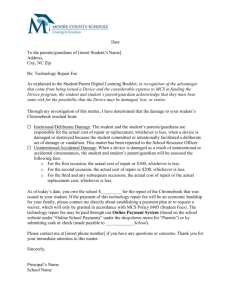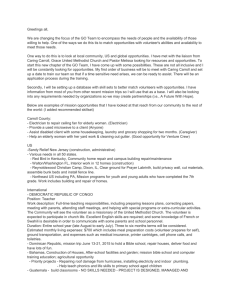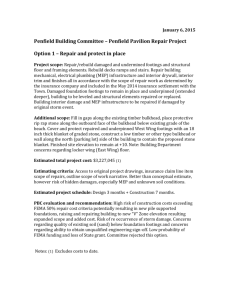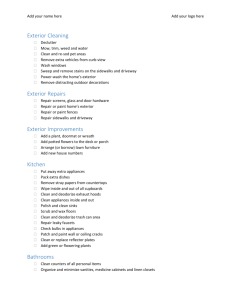Non-Structural Analysis and Damage Repair
advertisement
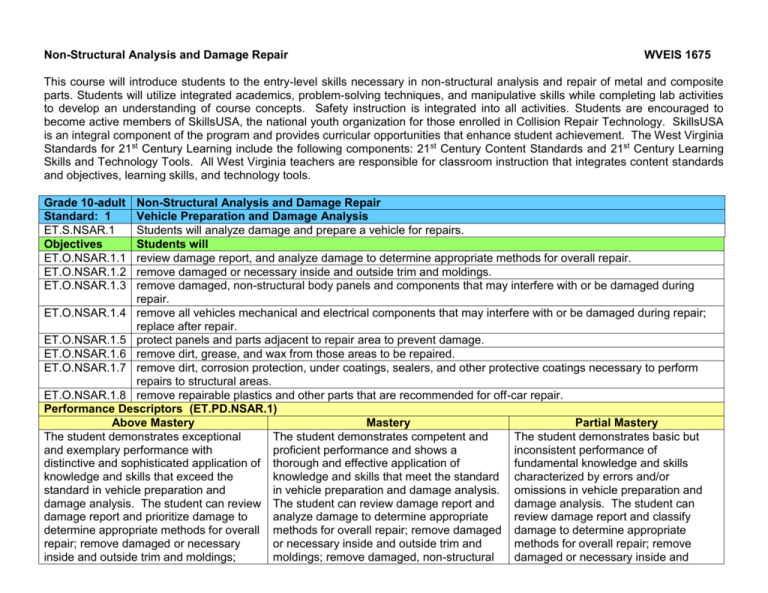
Non-Structural Analysis and Damage Repair WVEIS 1675 This course will introduce students to the entry-level skills necessary in non-structural analysis and repair of metal and composite parts. Students will utilize integrated academics, problem-solving techniques, and manipulative skills while completing lab activities to develop an understanding of course concepts. Safety instruction is integrated into all activities. Students are encouraged to become active members of SkillsUSA, the national youth organization for those enrolled in Collision Repair Technology. SkillsUSA is an integral component of the program and provides curricular opportunities that enhance student achievement. The West Virginia Standards for 21st Century Learning include the following components: 21st Century Content Standards and 21st Century Learning Skills and Technology Tools. All West Virginia teachers are responsible for classroom instruction that integrates content standards and objectives, learning skills, and technology tools. Grade 10-adult Standard: 1 ET.S.NSAR.1 Objectives ET.O.NSAR.1.1 ET.O.NSAR.1.2 ET.O.NSAR.1.3 Non-Structural Analysis and Damage Repair Vehicle Preparation and Damage Analysis Students will analyze damage and prepare a vehicle for repairs. Students will review damage report, and analyze damage to determine appropriate methods for overall repair. remove damaged or necessary inside and outside trim and moldings. remove damaged, non-structural body panels and components that may interfere with or be damaged during repair. ET.O.NSAR.1.4 remove all vehicles mechanical and electrical components that may interfere with or be damaged during repair; replace after repair. ET.O.NSAR.1.5 protect panels and parts adjacent to repair area to prevent damage. ET.O.NSAR.1.6 remove dirt, grease, and wax from those areas to be repaired. ET.O.NSAR.1.7 remove dirt, corrosion protection, under coatings, sealers, and other protective coatings necessary to perform repairs to structural areas. ET.O.NSAR.1.8 remove repairable plastics and other parts that are recommended for off-car repair. Performance Descriptors (ET.PD.NSAR.1) Above Mastery Mastery Partial Mastery The student demonstrates exceptional The student demonstrates competent and The student demonstrates basic but and exemplary performance with proficient performance and shows a inconsistent performance of distinctive and sophisticated application of thorough and effective application of fundamental knowledge and skills knowledge and skills that exceed the knowledge and skills that meet the standard characterized by errors and/or standard in vehicle preparation and in vehicle preparation and damage analysis. omissions in vehicle preparation and damage analysis. The student can review The student can review damage report and damage analysis. The student can damage report and prioritize damage to analyze damage to determine appropriate review damage report and classify determine appropriate methods for overall methods for overall repair; remove damaged damage to determine appropriate repair; remove damaged or necessary or necessary inside and outside trim and methods for overall repair; remove inside and outside trim and moldings; moldings; remove damaged, non-structural damaged or necessary inside and remove damaged, non-structural body panels and components that may interfere with or be damaged during repair; remove all vehicle mechanical and electrical components that may interfere with or be damaged during repair and replace after repair; protect panels and parts adjacent to repair area to prevent damage; remove dirt, grease, and wax from those areas to be repaired; remove dirt, corrosion protection, under coatings, sealers, and other protective coatings necessary to perform repairs to structural areas; and remove repairable plastics and other parts that are recommended for off-car repair while exceeding industry standards. The student can independently solve problems and is self-directed. Standard: 2 ET.S.NSAR.2 body panels and components that may interfere with or be damaged during repair; remove all vehicle mechanical and electrical components that may interfere with or be damaged during repair and replace after repair; protect panels and parts adjacent to repair area to prevent damage; remove dirt, grease, and wax from those areas to be repaired; remove dirt, corrosion protection, under coatings, sealers, and other protective coatings necessary to perform repairs to structural areas; and remove repairable plastics and other parts that are recommended for off-car repair while meeting industry standards. Application of knowledge and skills is thorough and effective, and the student can work independently. outside trim and moldings; remove damaged, non-structural body panels and components that may interfere with or be damaged during repair; remove all vehicle mechanical and electrical components that may interfere with or be damaged during repair and replace after repair; protect panels and parts adjacent to repair area to prevent damage; remove dirt, grease, and wax from those areas to be repaired; remove dirt, corrosion protection, under coatings, sealers, and other protective coatings necessary to perform repairs to structural areas; and remove repairable plastics and other parts that are recommended for off-car repair below industry standards. Performance needs further development and supervision. Integration of Academics and Applied Activities Students will: explore basic academics. participate in applied activities. Objectives Students will ET.O.NSAR.2.1 incorporate mathmatical concepts as related to non-structural analysis and damage repair. ET.O.NSAR.2.2 develop language skills as it applies to non-structural analysis and damage repair. ET.O.NSAR.2.3 integrate science related skills as it applies to non-structural analysis and damage repair. Performance Descriptors (ET.PD.NSAR.2) Above Mastery Mastery Partial Mastery The student demonstrates exceptional and exemplary performance with distinctive and sophisticated application of knowledge and skills that exceed the standard in integration of academics and applied activities. The student can incorporate mathematical concepts as related to non-structural analysis and damage repair; develop language skills as it applies to non-structural analysis and damage repair; and integrate science related skills as it applies to non-structural analysis and damage repair. The student can independently solve problems and is self-directed. The student demonstrates competent and The student demonstrates basic but proficient performance and shows a inconsistent performance of fundamental thorough and effective application of knowledge and skills characterized by knowledge and skills that meet the errors and/or omissions in integration of standard in integration of academics and academics and applied activities. The applied activities. The student can student can demonstrate mathematical implement mathematical concepts as concepts as related to non-structural related to non-structural analysis and analysis and damage repair; display damage repair; practice language skills as language skills as it applies to nonit applies to non-structural analysis and structural analysis and damage repair; damage repair; and execute science and demonstrate science related skills as related skills as it applies to non-structural it applies to non-structural analysis and analysis and damage repair. Application damage repair. Performance needs of knowledge and skills is thorough and further development and supervision. effective, and the student can work independently. Standard: 3 Exterior Panel Repair and Replacement ET.S.NSAR.3 Students will determine the extent of damage, plan method, and make outer body panel repairs, replacement, and adjustments. Objectives Students will ET.O.NSAR.3.1 determine the extent of the direct and indirect damage, the direction of impact, and plan the methods and order of repair. ET.O.NSAR.3.2 determine the extent of damage to aluminum body panels; repair or replace in accordance with manufacturer’s specifications. ET.O.NSAR.3.3 remove, replace, and align exterior sheet metal components and related hardware. ET.O.NSAR.3.4 remove, replace and align bumpers, reinforcements, guards, isolators, and mounting. ET.O.NSAR.3.5 check door hinge condition; check door frames for proper fit; check and adjust door clearances (where adjustable) along quarter panel, door, rocker panel, fender, and top. ET.O.NSAR.3.6 repair or replace door skins in accordance with vehicle manufacturer’s specification. ET.O.NSAR.3.7 straighten roughed out contours of damaged panel to a surface condition for body filling or metal finishing using power and hand tools. ET.O.NSAR.3.8 weld cracked or torn steel body panels; re-weld broken welds. ET.O.NSAR.3.9 shrink stretched panel areas back to contour. ET.O.NSAR.3.10 perform panel bonding. Performance Descriptors (ET.PD.NSAR.3) Above mastery Mastery Partial Mastery The student demonstrates exceptional and exemplary performance with distinctive and sophisticated application of knowledge and skills that exceed the standard in exterior panel repair and replacement. The student can assess the extent of the direct and indirect damage, the direction of impact, and plan the methods and order of repair; assess the extent of damage to aluminum body panels, repair or replace in accordance with manufacturer’s specifications; remove, replace, and align exterior sheet metal components and related hardware; remove, replace, and align bumpers, reinforcements, guards, isolators, and mounting; check door hinge condition; check door frames for proper fit; check and adjust door clearances along quarter panel, door, rocker panel, fender, and top; repair or replace door skins in accordance with vehicle manufacturer’s specification; straighten roughed out contours of damaged panel to a surface condition for body filling or metal finishing using power and hand tools; weld cracked or torn steel body panels and re-weld broken welds; shrink stretched panel areas back to contour; and perform panel bonding all while exceeding industry standards. The student can independently solve problems and is self-directed. Standard: 4 ET.S.NSAR.4 Objectives ET.O.NSAR.4.1 ET.O.NSAR.4.2 The student demonstrates competent and proficient performance and shows a thorough and effective application of knowledge and skills that meet the standard in exterior panel repair and replacement. The student can analyze the extent of the direct and indirect damage, the direction of impact, and plan the methods and order of repair; analyze the extent of damage to aluminum body panels, repair or replace in accordance with manufacturer’s specifications; remove, replace, and align exterior sheet metal components and related hardware; remove, replace, and align bumpers, reinforcements, guards, isolators, and mounting; check door hinge condition; check door frames for proper fit; check and adjust door clearances along quarter panel, door, rocker panel, fender, and top; repair or replace door skins in accordance with vehicle manufacturer’s specification; straighten roughed out contours of damaged panel to a surface condition for body filling or metal finishing using power and hand tools; weld cracked or torn steel body panels and re-weld broken welds; shrink stretched panel areas back to contour; and perform panel bonding all while meeting industry standards. Application of knowledge and skills is thorough and effective, and the student can work independently. The student demonstrates basic but inconsistent performance of fundamental knowledge and skills characterized by errors and/or omissions in exterior panel repair and replacement. The student can determine the extent of the direct and indirect damage, the direction of impact, and plan the methods and order of repair; determine the extent of damage to aluminum body panels, repair or replace in accordance with manufacturer’s specifications; remove, replace, and align exterior sheet metal components and related hardware; remove, replace, and align bumpers, reinforcements, guards, isolators, and mounting; check door hinge condition; check door frames for proper fit; check and adjust door clearances along quarter panel, door, rocker panel, fender, and top; repair or replace door skins in accordance with vehicle manufacturer’s specification; straighten roughed out contours of damaged panel to a surface condition for body filling or metal finishing using power and hand tools; weld cracked or torn steel body panels and reweld broken welds; shrink stretched panel areas back to contour; and perform panel bonding below industry standards. Performance needs further development and supervision. Plastic Repair Students will identify and repair various types of automotive plastics. Students will identify types of plastics to be repaired and their repair procedures. repair rigid and flexible plastic parts with urethane or epoxy adhesives and fiberglass reinforcements according to vehicle and industry specifications. ET.O.NSAR.4.3 remove damaged areas from rigid exterior Sheet Molded Compound (SMC) panels and repair with partial panel installation. ET.O.NSAR.4.4 reshape and shrink flexible exterior plastic parts. Performance Descriptors (ET.PD.NSAR.4) Above Mastery Mastery Partial Mastery The student demonstrates exceptional The student demonstrates competent and The student demonstrates basic but and exemplary performance with proficient performance and shows a inconsistent performance of distinctive and sophisticated application of thorough and effective application of fundamental knowledge and skills knowledge and skills that exceed the knowledge and skills that meet the standard characterized by errors and/or standard in plastic repair. The student in plastic repair. The student can categorize omissions in plastic repair. The can justify types of plastics to be repaired types of plastics to be repaired and their student can identify types of plastics to and their repair procedures; repair rigid repair procedures; repair rigid and flexible be repaired and their repair and flexible plastic parts with urethane or plastic parts with urethane or epoxy procedures; repair rigid and flexible epoxy adhesives and fiberglass adhesives and fiberglass reinforcements plastic parts with urethane or epoxy reinforcements according to vehicle and according to vehicle and industry adhesives and fiberglass industry specifications; remove damaged specifications; remove damaged areas from reinforcements according to vehicle areas from rigid exterior Sheet Molded rigid exterior Sheet Molded Compound and industry specifications; remove Compound (SMC) panels and repair with (SMC) panels and repair with partial panel damaged areas from rigid exterior partial panel installation; and reshape and installation; and reshape and shrink flexible Sheet Molded Compound (SMC) shrink flexible exterior plastic parts while exterior plastic parts while meeting industry panels and repair with partial panel exceeding industry standards. The standards. Application of knowledge and installation; and reshape and shrink student can independently solve problems skills is thorough and effective, and the flexible exterior plastic parts all below and is self-directed. student can work independently. industry standards. Performance needs further development and supervision. Standard: 5 Movable Glass ET.S.NSAR.5 Students will inspect, adjust, repair, or replace moveable glass and hardware. Objectives Students will ET.O.NSAR.5.1 inspect, adjust, repair, or replace window regulators, run channels, glass, power mechanisms, and related controls. ET.O.NSAR.5.2 repair or replace all power-driven accessories and related controls (including electrically-heated glass). ET.O.NSAR.5.3 diagnose and repair water leaks, dust leaks, and wind noises; inspect, repair, and replace weather stripping. ET.O.NSAR.5.4 inspect, repair, or replace, and adjust removable, manually-operated roof panels and hinges, latches, guides, handles, retainers, and controls of sunroofs. Performance Descriptors (ET.PD.NSAR.5) Above Mastery Mastery Partial Mastery The student demonstrates exceptional The student demonstrates competent and The student demonstrates basic but and exemplary performance with proficient performance and shows a inconsistent performance of fundamental distinctive and sophisticated application of thorough and effective application of knowledge and skills characterized by knowledge and skills that exceed the knowledge and skills that meet the errors and/or omissions in movable standard in movable glass. The student standard in movable glass. The student glass. The student can inspect, adjust, can inspect, adjust, repair, or replace can inspect, adjust, repair, or replace repair, or replace window regulators, run window regulators, run channels, glass, window regulators, run channels, glass, channels, glass, power mechanisms, and power mechanisms, and related controls; power mechanisms, and related controls; related controls; repair or replace all repair or replace all power-driven repair or replace all power-driven power-driven accessories and related accessories and related controls accessories and related controls (including controls (including electrically-heated (including electrically-heated glass); electrically-heated glass); find and repair glass); recognize and repair water leaks, diagnose and repair water leaks, dust water leaks, dust leaks, and wind noises; dust leaks, and wind noises; inspect, leaks, and wind noises; inspect, repair, inspect, repair, and replace weather repair, and replace weather stripping; and replace weather stripping; and stripping; and inspect, repair, or replace, and inspect, repair, or replace, and inspect, repair, or replace, and adjust and adjust removable, manually-operated adjust removable, manually-operated removable, manually-operated roof panels roof panels and hinges, latches, guides, roof panels and hinges, latches, guides, and hinges, latches, guides, handles, handles, retainers, and controls of handles, retainers, and controls of retainers, and controls of sunroofs all sunroofs all while meeting industry sunroofs all below industry standards. while exceeding industry standards. standards. Application of knowledge and Performance needs further development The student can independently solve skills is thorough and effective, and the and supervision. problems and is self-directed. student can work independently. Standard: 6 Participating in the Student Organization ET.S.NSAR.6 Students will participate in a local student organization Objectives Students will ET.O.NSAR.6.1 identify the purposes and goals of the student/professional organization. ET.O.NSAR.6.2 explain the benefits and responsibilities of participation in student/professional/civic organization as an adult ET.O.NSAR.6.3 demonstrate leadership skills through participation in student/professional/civic organization activities such as meetings, programs, and projects. Performance Descriptors (ET.PD.NSAR.6) Above Mastery Mastery Partial Mastery The student demonstrates The student demonstrates competent and The student demonstrates basic but exceptional and exemplary proficient performance and shows a inconsistent performance of fundamental performance with distinctive and thorough and effective application of knowledge and skills characterized by errors sophisticated application of knowledge and skills that meet the and/or omissions in participating in the student knowledge and skills that exceed the standard in participating in the student organization. The student identifies the standard in participating in the organization. The student identifies the purposes and goals of the student organization. student organization. The student purposes and goals of the student The student explains the benefits and examines the purposes, goals, organization. The student explains the responsibilities of participation in an benefits, and responsibilities of benefits and responsibilities of organization. The student demonstrates participation in a professional participation in an organization. The leadership skills through participation in student organization. The student student demonstrates leadership skills activities such as meetings, programs, and demonstrates leadership skills through participation in student activities projects. Performance needs further through participation in activities such as meetings, programs, and development and supervision. such as meetings, programs, and projects. Application of knowledge and projects. The student can skills is thorough and effective, and the independently solve problems and is student can work independently. self-directed. Standard: 7 Literacy and Numeracy ET.S.NSAR.7 Students will demonstrate the literacy and numeracy skills required to solve complex, real-world problems associated with their career/technical content area and improve their thinking and reasoning skills. Objectives Students will ET.O.NSAR.7.1 utilize a variety of technical sources (e.g., Internet, manuals, journals, directions, reports, etc.) to complete career/technical assignments and projects. ET.O.NSAR.7.2 demonstrate writing skills required to complete career/technical assignments and projects. ET.O.NSAR.7.3 demonstrate accuracy in calculating and measuring graphical work required to complete career/technical assignments and projects. ET.O.NSAR.7.4 analyze tables, charts, graphs and multiple data sources to complete career/technical assignments and projects. Performance Descriptors (ET.PD.NSAR.7) Above Mastery Mastery Partial Mastery The student demonstrates exceptional The student demonstrates competent The student demonstrates basic but and exemplary performance with and proficient performance and shows inconsistent performance of fundamental distinctive and sophisticated application a thorough and effective application of knowledge and skills characterized by of knowledge and skills that exceed the knowledge and skills that meet the errors and/or omissions in literacy and standard in literacy and numeracy. The standard in literacy and numeracy. The numeracy. The student selects a variety student chooses a variety of technical student utilizes a variety of technical of technical sources (e.g., Internet, sources (e.g., Internet, manuals, sources (e.g., Internet, manuals, manuals, journals, directions, reports, journals, directions, reports, etc.) to journals, directions, reports, etc.) to etc.) to complete career/technical complete career/technical assignments complete career/technical assignments assignments and projects; reproduces and projects; performs writing skills and projects; demonstrates writing skills writing skills required to complete required to complete career/technical required to complete career/technical career/technical assignments and assignments and projects; assignments and projects; projects; illustrates accuracy in communicates accuracy in calculating demonstrates accuracy in calculating calculating and measuring graphical work and measuring graphical work required and measuring graphical work required required to complete career/technical to complete career/technical to complete career/technical assignments and projects; and explains assignments and projects; and assignments and projects; and tables, charts, graphs and multiple data evaluates tables, charts, graphs and analyzes tables, charts, graphs and sources to complete career/technical multiple data sources to complete multiple data sources to complete assignments and projects. Performance career/technical assignments and projects. The student can independently solve problems and is self-directed. career/technical assignments and needs further development and projects. Application of knowledge and supervision. skills is thorough and effective and the student can work independently. Standard: 8 21st Century Learning Skills ET.S.NSAR.8 The student will access and manipulate information for use in oral, written, or multimedia format using appropriate technology skills. apply sound reasoning processes to solve complex real-world problems and develop new ideas. exhibit leadership and ethical behavior in planning and executing tasks, as an individual or a group member. Objectives Students will ET.O.NSAR.8.1 search online using a range of technology tools and media to access relevant information needed for problem solving. ET.O.NSAR.8.2 create information for oral, written, and multimedia communications, adhering to copyright laws. ET.O.NSAR.8.3 engage in problem solving and critical thinking processes to create and evaluate complex strategies in order to independently solve problems. ET.O.NSAR.8.4 adapt to new situations by considering multiple perspectives and a commitment to continued learning. ET.O.NSAR.8.5 exhibit ethical behavior and positive leadership while working collaboratively in the school and/or community. ET.O.NSAR.8.6 model legal and ethical behaviors in the use of technology. Performance Descriptors (ET.PD.NSAR.8) Above Mastery Mastery Partial Mastery The student demonstrates exceptional The student demonstrates competent The student demonstrates basic but and exemplary performance with and proficient performance and shows inconsistent performance of fundamental distinctive and sophisticated application a thorough and effective application of knowledge and skills characterized by of knowledge and skills that exceed the knowledge and skills that meet the errors and/or omissions in 21st century standard in 21st century learning skills. standard in 21st century learning skills. learning skills. The student explains The student assesses online technology The student searches online using a online technology tools and media to tools and media to access relevant range of technology tools and media to access relevant information needed for information needed for problem solving; access relevant information needed for problem solving; identifies information for critiques information for oral, written, problem solving; creates information for oral, written, and multimedia and multimedia communications, oral, written, and multimedia communications, adhering to copyright adhering to copyright laws; integrates communications, adhering to copyright laws; discusses problem solving and problem solving and critical thinking laws; engages in problem solving and critical thinking processes to create and processes to create and evaluate critical thinking processes to create and evaluate complex strategies in order to complex strategies in order to evaluate complex strategies in order to independently solve problems; discusses independently solve problems; interprets independently solve problems; adapts new situations by considering multiple new situations by considering multiple to new situations by considering perspectives and a commitment to perspectives and a commitment to continued learning; incorporates ethical behavior and positive leadership while working collaboratively in the school and/or community; and reinforces legal and ethical behaviors in the use of technology. The student can independently solve problems and is self-directed. multiple perspectives and a continued learning; reviews ethical commitment to continued learning; behavior and positive leadership while exhibits ethical behavior and positive working collaboratively in the school leadership while working collaboratively and/or community; and describes legal in the school and/or community; and and ethical behaviors in the use of models legal and ethical behaviors in technology. Performance needs further the use of technology. Application of development and supervision. knowledge and skills is thorough and effective and the student can work independently. Standard: 9 Entrepreneurship Skills ET.S.NSAR.9 Students will access the opportunities, concepts, processes, and personal traits/behaviors associated with successful entrepreneurial performance. Objectives Students will ET.O.NSAR.9.1 assess global trends in entrepreneurship that are related to their career/technical program. ET.O.NSAR.9.2 determine entrepreneurial opportunities in venture creation related to their career/technical program. ET.O.NSAR.9.3 examine desirable entrepreneurial personality traits. Performance Descriptors (ET.PD.NSAR.9) Above Mastery Mastery Partial Mastery The student demonstrates exceptional The student demonstrates competent The student demonstrates basic but and exemplary performance with and proficient performance and shows inconsistent performance of fundamental distinctive and sophisticated application a thorough and effective application of knowledge and skills characterized by of knowledge and skills that exceed the knowledge and skills that meet the errors and/or omissions in standard in entrepreneurship skills. The standard in entrepreneurship skills. The entrepreneurship skills. The student lists student critiques global trends in student assesses global trends in global trends in entrepreneurship that are entrepreneurship that are related to their entrepreneurship that are related to related to their career/technical program; career/technical program; evaluates their career/technical program; describes entrepreneurial opportunities in entrepreneurial opportunities in venture determines entrepreneurial venture creation related to their creation related to their career/technical opportunities in venture creation related career/technical program; and identifies program; and assesses desirable to their career/technical program; and desirable entrepreneurial personality entrepreneurial personality traits. The examines desirable entrepreneurial traits. Performance needs further student can independently solve personality traits. Application of development and supervision. problems and is self-directed. knowledge and skills is thorough and effective and the student can work independently.
